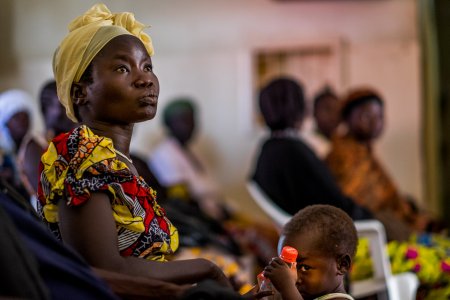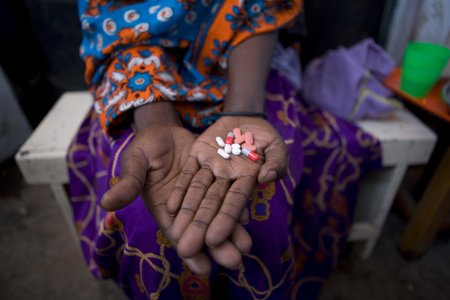
What AIDS teaches us
Rony Brauman
On Friday, 21 January 2022, Rony Brauman took part in the Académie des Sciences d’Outre-Mer and Académie Nationale de Médecine’s joint session on the stakes and challenges of healthcare globalisation. This article is an edited transcript of his talk; the video is also available on our website (in French).
In this presentation he identifies the dynamics and events that made bending the HIV/AIDS epidemic curve possible. He explains the climate in which the tug-of-war with parts of the pharmaceutical industry played out from MSF’s perspective, and recalls that fears about international security and political stability also helped push governments to mobilise against the epidemic.
Chairpersons and permanent secretaries of both assemblies,
Ladies and gentlemen,
Introduction
I would like to thank Dr. Chippaux, along with the chairpersons and permanent secretaries of both Academies for the opportunity to share the secrets that AIDS has taught me, if the Chair of the National Academy of Medicine’s announcement is to be believed.
Naturally, this disease has told me very few secrets. However, I’ve been able to follow, as a collective practitioner – that is, a member of a medical aid organisation that was deeply involved in the HIV epidemic – the many issues that came up at that time, and we are well-positioned to see the extent to which epidemics create questions or new problems.
Range of issues revealed by the AIDS epidemic
I could, for example, have discussed a new and quite interesting medical situation – namely, the birth of what we now call “health democracy”. It manifests as a significantly greater involvement of patients and their loved ones in defining clinical trial protocols, and even their ethical framework, which had previously been the exclusive domain of medical practitioners. The extent to which health democracy has infiltrated other areas of medical practice is still up for debate, but this new way of doing things – which has allowed real advances in health care – began with AIDS.
By the same token, it would have been totally possible to highlight the very rapid advances in knowledge. From the early 1980s, when a new, completely unknown syndromeIn the beginning it was dubbed the “gay cancer”.
I could also – and this is an opportunity for me to discuss what I feel are essential medical and public health issues – have talked to you about the history of AIDS as an iatrogenic disease. The role of large scale public health campaigns in the epidemic’s explosion – I’m thinking of the first sleeping sickness campaigns in the 1920s and ‘30s and the widespread use of infusions and vaccination shots in the 1960s and ‘70s – seems much more important than the supposed sexual frenzy of Africans, a racist, colonialist view that is far from the reality, which is more prosaic and disturbing.
I could also – and I’ll stop the litany of subjects that I will not be talking about there – have pointed to the WHO’s feeble response, its inertia reminiscent of the one it showed during the 2014 Ebola epidemic. That feeble response was more or less made up for – with many disadvantages and a few advantages – by the proliferation of institutions like UNAIDS (1995), the Global Fund (2002) and UNITAID (2006), institutions that in some way filled the vacuum left by the WHO.
Access to antiretrovirals (ARVs)
I’ve decided to take a different angle for the analysis – that of a private humanitarian actor, Médecins Sans Frontières (MSF), engaged in a campaign to expand access to antiretrovirals. I will revisit the tug-of-war that was going on at the time with several institutions and especially with some in the pharmaceutical industry. As I mentioned at the start of my talk, antiretroviral therapies – which are highly effective against AIDS – were produced and administered starting in 1995-96. However, for business reasons – to protect intellectual property and compartmentalise the pharmaceutical markets – those drugs were reserved for patients in the Global North. To combat that worldwide “healthcare apartheid”, a number of NGOs (Oxfam, Treatment Action Campaign, and MSF, in particular) launched a campaign using the slogan, “The patients are in the South, the medicines are in the North”.
Obviously there were patients in the North, but it was largely in Africa that the epidemic had progressed to the point of killing millions of people. Remember, for example, that of the thirteen million documented AIDS orphans in the world in the late 1990s, twelve million were living in Africa.
The campaign ran into strong opposition from the pharmaceutical industry. The porousness between political authority and the pharmaceutical industry raises many questions – and the Covid-19 pandemic in no way contradicts this; on the contrary, just look (for example) at the policy on vaccine prices today and the stunning, outrageous profits that private companies are making using the results of publicly-funded research. The pharmaceutical industry used two types of arguments to justify the draconian rationing of ARVs: a public health argument and an economic argument.
The public health argument cast doubt on the capacity for treatment compliance by mostly illiterate patients who didn’t have a watch, which supposedly rendered them incapable of following a long-term regimen requiring them to both take their medicines at a set time, without forgetting, and abide by the constraints of disease follow-up. In brief, they were allegedly incapable of understanding where their interests lie, with the result – due to irregular, and thus ineffective, dose-taking – that resistant strains of the virusJohn Donnelly, “Prevention urged in AIDS fight. Natsios says fund should spend less on HIV treatment”, Boston Globe, 7 June 2001.
That policy had already prevailed with regard to tuberculosis until the early 2000s. A large number of TB patients who could have been treated were literally condemned to death by the slogan “better not treat than mistreat”. This was done to tens of thousands of patients based on the assumption that they were incapable of properly following a treatment protocol that, at the time, took six months to a year. So while the objection wasn’t new, it had particularly severe consequences, given the scale and progression of the AIDS epidemic globally. MSF took it upon itself to show that the noncompliance argument, and thus the threat of ARV resistance, was based on assumption, not observation. And we won that bet; today, the level of compliance in the AIDS programmes we support in Africa is quite good, with clinical results, impact on containment of the epidemic, and increase in life expectancy that are quite comparable to what we see in developed countries.
The second argument, which was in some sense an extension of the first, had to do with protecting intellectual property to ensure funding for new drug research. According to pharmaceutical industry representatives, generic ARV production would threaten the industry’s capacity for innovation. Recall that in 1994, when the WTO was created, the principles of trade law were applied to intellectual property rights, prohibiting developing countries from producing generic forms of new medications. Those agreements were renegotiated in the early 2000s to facilitate implementation of compulsory licensing in case of healthcare-related need.
While pharmaceutical research indisputably requires significant financing, it is helpful to remember that: 1/ most of the major drug classes discovered prior to the mid-1970s – in other words, a good part of the treatment arsenal still in use today – were produced without patent protection; and 2/ many of those drugs were developed via publicly-funded research, which is the case for ARVs, in particular, which came out of publicly-funded labs in the United States.
Bent on protecting their patents, the drug industry was determined to fight those whom Bill Gates once called “some new modern-day sort of communists […] under various guisesInterview given to News.com on 5 January 2005 on the sidelines of the Consumer Electronics Show in Las Vegas.”.
The Pretoria lawsuit
It was in this context of stark economic and political polarisation that an event that would apparently turn the tide occurred. In 2001, thirty-nine pharmaceutical companies decided to sue the South African government, which had arranged for what is called “parallel importation”This term refers to the importation of a product, in this case ARVs, without the permission of the intellectual property right-holder., considered illegal, of ARVs from India. India has a large pharmaceutical industry – manufacturing generic drugs, in particular – that is among India’s national values, like Renault and the CEA were once national values in France. India, sometimes nicknamed “the pharmacy of the third world”, was supplying ARVs to South Africa, which was, as we know, especially hard-hit by the AIDS epidemic. For their part, the South African government had been wreathed in the halo of apartheid’s dismantlement, and was still glowing with the presidency of Nelson Mandela, who had left power in 1999 but remained on the political scene. Despite the positions of President Thabo Mbeki, who disputed the viral origin of AIDS, the government was still enjoying an aura that, though well faded in recent years, was still remarkable when the lawsuit began.
A robust international campaign supported by most of the media was set in motion by numerous associations and NGOs, including MSF, Oxfam, and Treatment Action Campaign. The latter, though less well-known than MSF and Oxfam, is a large South African association. Led by activists from the ANC (African National Congress), in particular, most of them former anti-apartheid activists, it enjoyed considerable political legitimacy and an aura of integrity, and conducted an extraordinary mobilisation effort. In addition, some of its leaders, themselves HIV-positive, had declared publicly that they were refusing treatment until ARVs were available to everyone in their country; they were literally placing their lives on the line. That gives an idea of the fervour and intensity of the local mobilisationhttps://msf-crash.org/en/publications/agir-tout-prix-negociations-humanitaires-lexperience-de-msf/i-stories#south-africa.-msf,-an-african-ngo?.
The campaign, whose slogan was “Drop the Case”, was a huge success, since the pharmaceutical companies did indeed withdraw. They dropped their case, pathetically giving in in the face of general condemnation, with some of their executives privately – and some even publicly – calling the case a catastrophic mistake and major public relations error. ARVs then became affordable, their cost falling by 99% thanks to the lifting of intellectual property rights; triple therapies went from ten thousand to a hundred dollars a year.
The elimination of that financial barrier, combined with an unprecedented budgetary effort in the healthcare realm, has made large-scale deployment of remarkably effective resources to fight AIDS possible over the past twenty years. Let’s remember that treating a patient to the point of undetectable viral load also means interrupting future transmission. We should also note, in passing, that the pharmaceutical companies whose patents were lifted have seen no effect on their profits. The populations benefitting from this, not being creditworthy, were not a market the pharmaceutical companies would have unduly been deprived of.
Of the forty-some-odd million people now living with HIV, nearly thirty million are under treatment, and an estimated six million do not know their serological status. So the fight against AIDS isn’t over – will it ever be? – but considerable progress, undreamed of even a short time ago, has been made.
Security issues
Were the tug-of-war between NGOs, patient organisations, and pharmaceutical companies and the turning of public opinion against the pursuit of profit sufficient to account for that victory? That’s the general tenor of the accounts about it from the organisations involved.
It is in no way to deny the legitimacy and appropriateness of the fight led by those NGOs, and especially TAC, to doubt that such mobilisation, though necessary, was sufficient to reverse the course of events so abruptly. It is what is missing from that story that I’m going to talk briefly about now.
Around the turn of the twenty-first century a series of reports from various sources were published pointing out the dangerous political consequences of the epidemic. I’m thinking of how UNAIDS began talking, in 1998, about infection rates that were five times higher in the African armed forces than in the civilian population“AIDS and the military”, May 1998, cited in “Le Sida en Afrique subsaharienne : perceptions d’un enjeu de sécurité internationale”, Fanny Chabrol, La Revue internationale et stratégique, No. 46, Summer 2002.. I am also – and perhaps especially – thinking of the conjunction of a CIA report“The global infectious disease threat and its implications for the United States”, National Intelligence Council, January 2000.
Foundations and convergence of currents of thought
This is not to contrast a passionate social movement led by civil society organisations with the cold pragmatic policy spearheaded by the United States, but rather to observe that the availability of effective, affordable treatments was made possible by a unique combination of circumstances: significant scientific progress (virus identification and ARV development), humanitarian mobilisation supported by public opinion and the media, and finally security fears that prompted governments – the most powerful one, in particular – to intervene.
So it was where the scientific, the social, and the political intersected that this progress was achieved – a configuration seen before under other circumstances and described, in particular, by anthropologist Didier FassinL’Espace politique de la santé, Essai de généalogie, PUF, 1996.. He noted that the first population that public health took an interest in was the infants of poor families, in the late nineteenth century. He wondered why what some called “the massacre of innocents” – so high was the mortality rate – left the realm of the inexorable to become a cause for concern requiring that measures be taken. The author saw several converging reasons for that profound change. The first was the decline in the birth rate and resulting demographic weakening, which worried the government in a context where recovery vis-à-vis Germany after its victory in the Franco-Prussian War and the need for manpower to exploit colonial lands presented strategic challenges. Next was the philanthropic movement – especially in Christian progressive circles – in a context of growing inequality and enormous poverty, in which humanitarian associations proliferated. And lastly there was scientific progress – the discovery of microbes as the cause of infection, which led to pasteurisation of the milk given to infants and sterilisation of baby bottles, which reduced their mortality rate, especially in summertime. The “Œuvre de la goutte de lait”, founded in 1895, is a remarkable illustration of this. The distribution of pasteurised milk to infants after consultation and provision of childcare classes for mothers constituted both a medical and moral programme that spread widely in France and continued in some regions into the 1970s. Scientific discoveries, philanthropic movements, and political interests have thus created a new kind of space inside which innovations can be transformed into large-scale social practices.
A few words in conclusion
This model shows us the conditions that are necessary, but not sufficient – almost imperative, however – to paradigm change. But it has its limits; it tells us nothing, of course, about important phenomena like the passionate commitment of the first medical teams confronted with this mysterious disease, or other political obstacles that hindered the start of AIDS control programmes. Hence to the various themes I mentioned at the start of my talk I could have added local governance and corruption, issues that were mentioned in other talks in this symposium in terms of the Ebola and COVID epidemics – in the DRC, in particular, where there have been massive diversions of billions of dollars. The local populations, aware of and outraged by this predation, protest and take it out on healthcare teams that are not necessarily involved in the theft but pay the price for it. There again, we see the extent to which the fight against epidemics extends to all aspects of politics, right down to ground level. But that’s another story, which I won’t go into. So I’m going to stop there by thanking you for your attention.
To cite this content :
Rony Brauman, “What AIDS teaches us”, 16 septembre 2022, URL : https://msf-crash.org/en/medicine-and-public-health/what-aids-teaches-us
If you would like to comment on this article, you can find us on social media or contact us here:
Contribute


